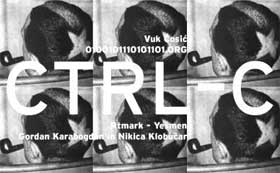 Last May, i blogged about Plagiarismo, an exhibition that tried to demonstrate that the appropriation and re-formulation of other artists’ ideas is an essential component of culture.
Last May, i blogged about Plagiarismo, an exhibition that tried to demonstrate that the appropriation and re-formulation of other artists’ ideas is an essential component of culture.
Vuk Cosic – who’s having a solo exhibition at the Å kuc Gallery in Ljubljana- wrote me then that he was putting together a show called CTRL-C on a similar subject. The show has just opened at the galerija Simulaker in Slovenia. Here’s the gist:
From Duchamp and Benjamin to Beuys the art of the previous century has asked the question of copying and multiplying as a legitimate artistic practice. The advent of the internet has dramatically placed the digital original and digital copy in the very center of artistic but also economic frictions.
Mere simplicity of making copies is socially not perceived as a liberating tool for artistic creation but is turning out to be the main point of conflict between economic interests and those of societies at large. Traditionalists fighting for Intellectual Property are trying to pull the giants from under our feet.
The CTRL-C show is presenting projects exclusively focused on the artistic relevance of the digital copy. Exhibited works are using the language of the non-original to express a very concrete critique of the circumstances in the world of art and in the society. All works in the show have provided their authors with a measure of scandal and a bigger measure of fame:
In September 1997, Vuk Ćosić made an almost perfect copy of the website of Documenta X before it was taken down by the organisers of the famous contemporary art show. The artist saw his act as an “expression of a rebellion against the art system and the return of art from a gallery into reality.�
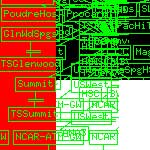 Epilogue: The copy found its way into relevant “kunst.historischâ€? literature and is still accessible on the author’s internet server. Being a legitimate and conceptual work it has been exhibited many times, also at the Venice Bienale in 2001.
Epilogue: The copy found its way into relevant “kunst.historischâ€? literature and is still accessible on the author’s internet server. Being a legitimate and conceptual work it has been exhibited many times, also at the Venice Bienale in 2001.
In 1997, 0100101110101101.ORG made a series of clones of well-known net.art projects (hell.com, art teleportacia, Jodi) as a digital monument to the principles upon which the Internet runs. “The belief that information must be free,” explained at the time Renato, 0100101110101101.ORG spokesman, “is a tribute to the way in which a very good computer or a valid program works: binary numbers move in accordance with the most logic, direct and necessary way to do their complex function. What is a computer if not something that benefits by the free flow of information? Copyright is boring.”
Epilogue: The three copies are still accessible on the authors’ server. Nowadays they are known for their numerous net.art projects, acknowledged by the public and the media.
In 1999, Rtmark – The Yes Men altered the website of the World Trade Organization and made it very similar to the original. They received invitations to symposia (no one’s going to forget their talk and little demo at the Textiles of the Future conference in Tampere), where they presented the identity of GATT as they understood it.
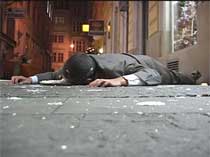
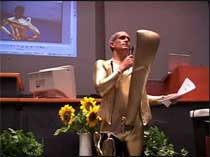 Yes Men stunts in Salzburg and Tampere
Yes Men stunts in Salzburg and Tampere
Epilogue: The authors belong to the group of the most recognizable names of the New Media scene. A documentary has been made about their work (also available on google video btw.)
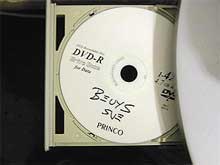 During the exhibition of Fluxus in 2005, Gordan Karabogdan and Nikica KlobuÄ?ar snatched a few of Beuys’ videos, copied them at their home and returned the “originals” without anyone noticing it. They even produced free copies and the media comprehended this deed as a criminal act.
During the exhibition of Fluxus in 2005, Gordan Karabogdan and Nikica KlobuÄ?ar snatched a few of Beuys’ videos, copied them at their home and returned the “originals” without anyone noticing it. They even produced free copies and the media comprehended this deed as a criminal act.
Epilogue: The work, called Enigma of an object, ended with an act of handing over the copied films and entire documentation to the Museum of Modern and Contemporary Art in Rijeka.
Thanks Vuk for the information and translations!
